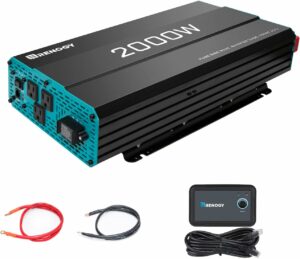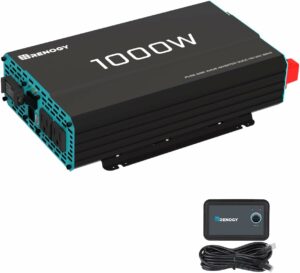Solar Inverter For Off-Grid RV
Introduction
Welcome to the realm of off-grid RV living, where freedom meets sustainability.
In this dynamic lifestyle, adventurers break free from conventional power constraints, relying on the efficiency of solar systems.
Solar inverters are at the heart of this energy revolution, the unsung heroes converting sunlight into power for RV appliances.
Join us as we delve into the essentials, advantages, and innovations that define the off-grid experience, empowering individuals to roam untethered and embrace a self-sufficient journey on the open road.
Provo Green Products embodies a beacon of trust in sustainable discoveries, offering choices that enhance your life and leave a positive mark on our planet.
Leveraging extensive expertise in manufacturing, construction, and various trades, we provide a solid foundation for sustainable living.
Our meticulous research process guarantees that our information about each product is precise and current, allowing you to make informed decisions.
Whether your interest lies in solar products, electric bikes, or other eco-friendly alternatives, our commitment to credibility ensures you have access to dependable insights, guiding your journey toward a more sustainable lifestyle.
Provo Green Products is your go-to destination for finding the right green products for your lifestyle.
Disclosure: We may earn a small commission if you click on one of our links. This will not affect the pricing of the product whatsoever.
Off-Grid RV Living
Living off-grid in an RV represents a lifestyle choice emphasizing self-sufficiency and a closer connection to nature.
In this mode of living, individuals or families choose to reside in recreational vehicles (RVs) that are not connected to traditional utility services such as electricity, water, or sewage.
The focus is on embracing a more sustainable and independent way of life, often in remote or less populated areas.
- Overview of Off-Grid RV Lifestyle:
- Off-grid RV living involves relying on alternative energy sources, such as solar power, to meet daily energy needs.
- The freedom to travel and set up camp in diverse natural settings is a key appeal, allowing for a change of scenery and experiences.
- Importance of Reliable Power Sources:
- Power is a fundamental aspect of off-grid RV living, facilitating essential activities like cooking, lighting, and charging electronic devices.
- Unlike traditional homes, where electricity is readily available, off-grid RV dwellers must carefully consider and manage their power sources to ensure a comfortable and functional living space.
Understanding Solar Inverters
Explanation of Solar Inverters:
- Functionality: Solar inverters serve as the heart of an off-grid RV’s power system, converting the direct current (DC) generated by solar panels into the alternating current (AC) used by most RV appliances. This process enables the seamless integration of solar energy into the RV’s electrical system.
- Types of Inverters: There are two primary types of solar inverters: pure sine wave and modified sine wave. A pure sine wave inverter produces a smooth and consistent waveform, mimicking the quality of grid power. On the other hand, a modified sine wave inverter generates a stepped waveform, suitable for simpler electronics but potentially causing issues with sensitive devices.
Types of Solar Inverters Suitable for RVs:
- On-Grid vs. Off-Grid vs. Hybrid Inverters: On-grid inverters are designed for grid-tied systems, sending excess energy back to the grid. Off-grid inverters, crucial for RVs, operate independently of the grid, relying solely on solar power and often incorporating battery storage. Hybrid inverters combine the features of both, allowing for grid connectivity and off-grid autonomy.
- Considerations for RVs: RVs require inverters that are compact, lightweight, and capable of handling the unique power demands of mobile living. Exploring inverters with features like remote monitoring, temperature regulation, and compatibility with RV charging systems enhances the suitability for these environments.
Understanding these nuances empowers RV enthusiasts to make informed decisions when selecting a solar inverter, ensuring it aligns with their specific energy needs and the nature of off-grid living.
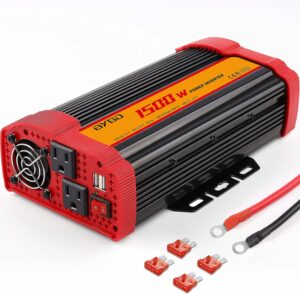
Key Features to Look for in an Off-Grid RV Solar Inverter
Power Capacity and Efficiency:
- Understanding RV Power Needs: Before selecting a solar inverter, it’s crucial to assess the power requirements of all onboard appliances and electronics. This includes everything from lights and refrigerators to electronic devices.
- Calculating Power Capacity: Choose an inverter with sufficient power capacity to handle the peak load demands. Consider factors like startup surges and simultaneous use of multiple devices. Opting for an inverter with a power rating slightly higher than the calculated needs ensures flexibility and reliable performance.
- High Efficiency: Efficiency is paramount for off-grid living. Look for inverters with high efficiency ratings, as this translates to less energy loss during the conversion process, maximizing the power harvested from solar panels.
Compatibility with RV Appliances:
- Versatility in Outlets: A good off-grid solar inverter should offer a variety of outlets, including standard AC outlets and USB ports. This ensures compatibility with a wide range of RV appliances and electronic devices.
- Pure Sine Wave Output: While modified sine wave inverters are suitable for many applications, some sensitive electronics, like certain medical devices or high-end audio equipment, may require a pure sine wave output. Consider the specific needs of your RV lifestyle when choosing the waveform type.
Durability and Weather Resistance:
- Outdoor Exposure Challenges: RVs often face diverse weather conditions, from scorching sun to heavy rain. The solar inverter should be durable and capable of withstanding these elements without compromising performance.
- Moisture Resistance: Look for inverters with moisture-resistant coatings and enclosures. This prevents corrosion and electrical issues, ensuring the longevity of the inverter in outdoor environments.
Ease of Installation:
- User-Friendly Design: Choose an inverter with a user-friendly design for easy installation. This is especially important for RV enthusiasts who may not have extensive technical expertise. Clear instructions and labeled connection points simplify the setup process.
- Expandability: Consider inverters that allow for easy expansion, accommodating future additions to your solar power system, such as extra panels or a larger battery bank.
Advanced Features for Monitoring and Control:
- Remote Monitoring: Opt for inverters with remote monitoring capabilities. This allows you to track energy production and consumption from a distance, providing valuable insights into system performance.
- Temperature Regulation: Inverters equipped with temperature regulation features ensure optimal performance in varying weather conditions. This is crucial for maintaining efficiency and extending the lifespan of the inverter.
By prioritizing these key features, RV enthusiasts can select a solar inverter that not only meets their current power needs but also provides flexibility and reliability for their off-grid adventures.
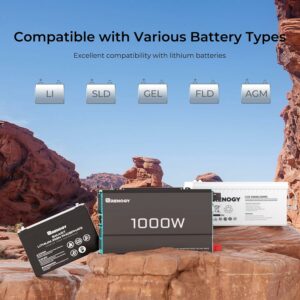
Installation Guide for Solar Inverters in RVs
Step-by-Step Installation Process:
- Assess RV Power Needs: Begin by conducting a thorough assessment of your RV’s power needs. List all the appliances and electronics you plan to power with the solar inverter. Consider peak loads and simultaneous use to determine the required inverter capacity.
- Select an Appropriate Location: Choose a suitable location for installing the solar inverter. It should be easily accessible, well-ventilated, and protected from extreme weather conditions. Consider the inverter’s size and weight when determining the installation space.
- Mounting the Inverter: Securely mount the inverter using appropriate hardware. Ensure it is positioned in a way that allows for efficient heat dissipation. Follow the manufacturer’s guidelines for orientation and clearance.
- Connecting Solar Panels: Connect the solar panels to the inverter following the provided wiring diagrams. Use appropriate cables and connectors, and ensure proper polarity to prevent any electrical issues. Securely fasten cables to prevent damage during travel.
- Battery Connection: Connect the inverter to the RV’s battery bank. Use high-quality cables and connectors capable of handling the inverter’s power output. Follow safety precautions to avoid electrical shocks or short circuits.
- AC Wiring: Connect the inverter’s AC output to the RV’s electrical system. This may involve wiring the inverter to the main distribution panel or installing dedicated outlets for specific appliances. Double-check all connections to ensure proper wiring.
- Testing the System: Before finalizing the installation, perform a comprehensive test of the entire system. Verify that the solar panels are generating power, the inverter is converting DC to AC correctly, and all connected appliances are functioning as expected.
Safety Precautions and Considerations:
- Shut Off Power Sources: Prior to installation, disconnect all power sources, including shore power and generator, to ensure a safe working environment. This prevents accidental electrical shocks during the installation process.
- Use Personal Protective Equipment (PPE): Wear appropriate PPE, including gloves and safety goggles, to protect yourself during the installation. Dealing with electrical components requires careful attention to safety.
- Follow Manufacturer Guidelines: Adhere strictly to the manufacturer’s guidelines provided in the user manual. This ensures the correct installation procedure and helps avoid potential issues that may void the warranty.
Post-Installation Tips:
- Documentation: Keep detailed documentation of the installation process, including wiring diagrams, component specifications, and any modifications made. This documentation is valuable for troubleshooting and future maintenance.
- Regular Inspections: Schedule regular inspections to ensure all connections remain secure and free of corrosion. Check for any signs of wear or damage to cables, and address issues promptly to prevent performance issues.
- Update System as Needed: As your RV setup evolves, such as adding more solar panels or upgrading battery capacity, update the solar inverter system accordingly. This ensures it continues to meet your power needs effectively.
By following these step-by-step instructions and adhering to safety guidelines, RV enthusiasts can confidently install a solar inverter system, harnessing the power of the sun for a sustainable and self-sufficient off-grid lifestyle.
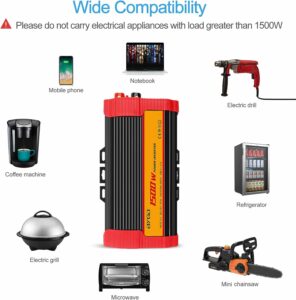
Maintenance Tips for Optimal Solar Inverter Performance
Regular Checks and Cleaning:
- Inspecting Solar Panels: Regularly inspect solar panels for any dirt, dust, or debris that might accumulate on the surface. Clean panels gently with a soft brush or cloth to ensure maximum sunlight absorption. Remove any obstructions that could cast shadows on the panels.
- Visual Inspection of Inverter: Periodically visually inspect the solar inverter for signs of wear, damage, or loose connections. Check for any unusual noises or odors during operation, as these could indicate potential issues.
Troubleshooting Common Issues:
- Monitoring System Performance: Use the inverter’s monitoring features to keep track of system performance. Look for any fluctuations or irregularities in power output. This can be an early indicator of potential problems that may need attention.
- Addressing Fault Codes: Familiarize yourself with the inverter’s fault codes and troubleshooting guide. In the event of a fault, refer to the guide to identify and address the issue promptly. This proactive approach helps prevent prolonged system downtime.
Extending the Lifespan of the Solar Inverter:
- Temperature Control: Ensure that the inverter is installed in a location with proper ventilation to dissipate heat effectively. High temperatures can affect the efficiency and lifespan of the inverter. Consider adding ventilation or fans if needed.
- Timely Replacements: Components like capacitors may have a limited lifespan. Keep track of the inverter’s age and the expected lifespan of its components. Plan for timely replacements to avoid unexpected failures.
Optimizing Energy Storage (if applicable):
- Battery Maintenance: If your off-grid RV setup includes energy storage in the form of batteries, perform regular maintenance on the battery bank. Check fluid levels, clean terminals, and ensure proper ventilation around the batteries.
- Equalization Charging: Depending on the battery type, perform equalization charging as recommended by the battery manufacturer. This process helps balance cell voltages and extends the overall life of the battery bank.
Software and Firmware Updates:
- Stay Informed: Keep yourself informed about any software or firmware updates released by the inverter manufacturer. These updates may include performance improvements, bug fixes, or new features that enhance the overall functionality of the inverter.
- Scheduled Updates: Plan scheduled updates during periods of low energy demand to minimize any potential disruptions. Follow the manufacturer’s guidelines for updating the inverter’s software or firmware.
Documentation and Record-Keeping:
- Maintain Records: Keep detailed records of all maintenance activities, including cleaning dates, inspections, and any replacements made. This documentation is valuable for troubleshooting and warranty purposes.
- Manufacturer Recommendations: Follow the manufacturer’s recommendations for maintenance intervals and procedures. Adhering to these guidelines ensures that your solar inverter operates at peak efficiency throughout its lifespan.
By incorporating these maintenance tips into your routine, you can maximize the performance and longevity of your solar inverter, contributing to a reliable and sustainable off-grid RV lifestyle.
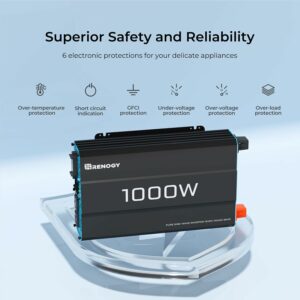
Conclusion
Maintaining a solar inverter for optimal performance in off-grid RV living is essential for a seamless and sustainable lifestyle.
Regular checks, cleaning, and troubleshooting help prevent issues, ensuring reliable power.
Temperature control and timely replacements extend the inverter’s lifespan. Stay informed about software updates and keep meticulous records.
By following these maintenance tips, RV enthusiasts can harness solar energy effectively, enhancing their off-grid experience with a dependable and efficient power system.
Stay in Touch!
I’am a dedicated entrepreneur with many years of experience and an integrity-driven individual who is highly motivated to succeed. Leveraging extensive expertise in manufacturing, construction, and various trades, we can provide a solid foundation for sustainable living. Our meticulous research process guarantees that our information about each product is precise and current, allowing you to make informed decisions. A deep understanding of business operations empowers me to consistently implement improvements that result in ongoing success. Visit site.

